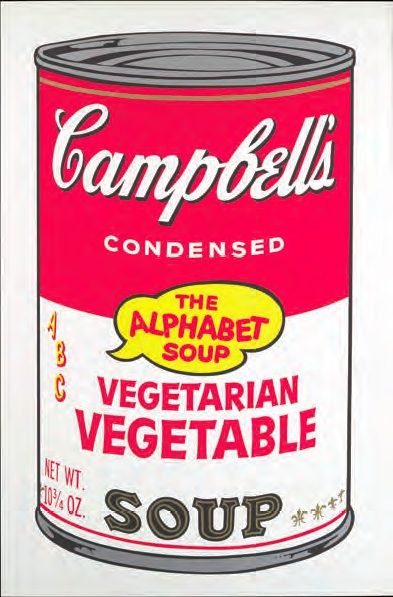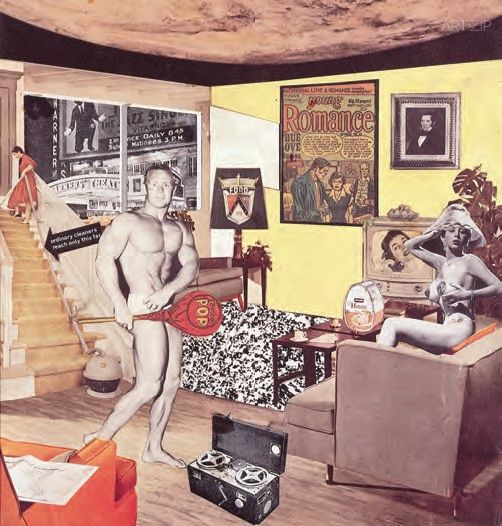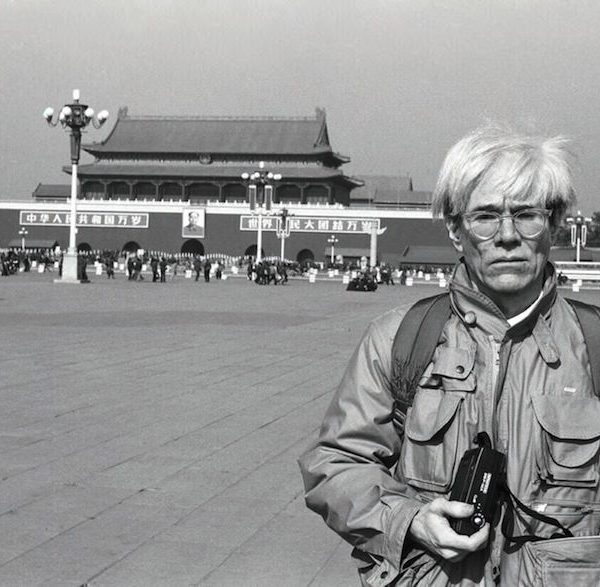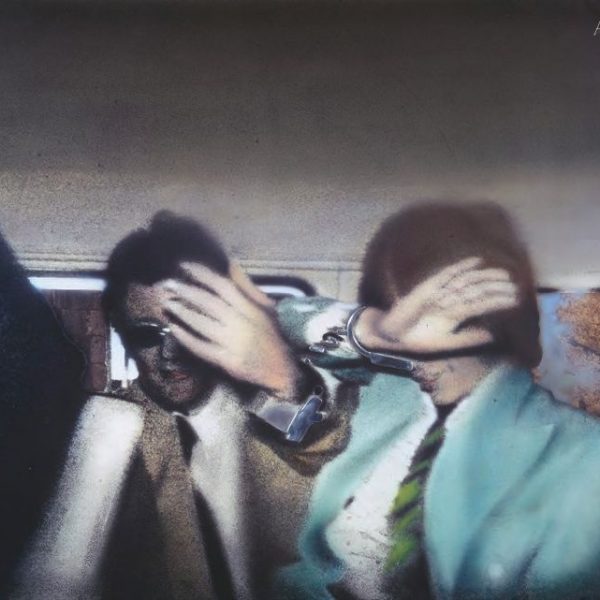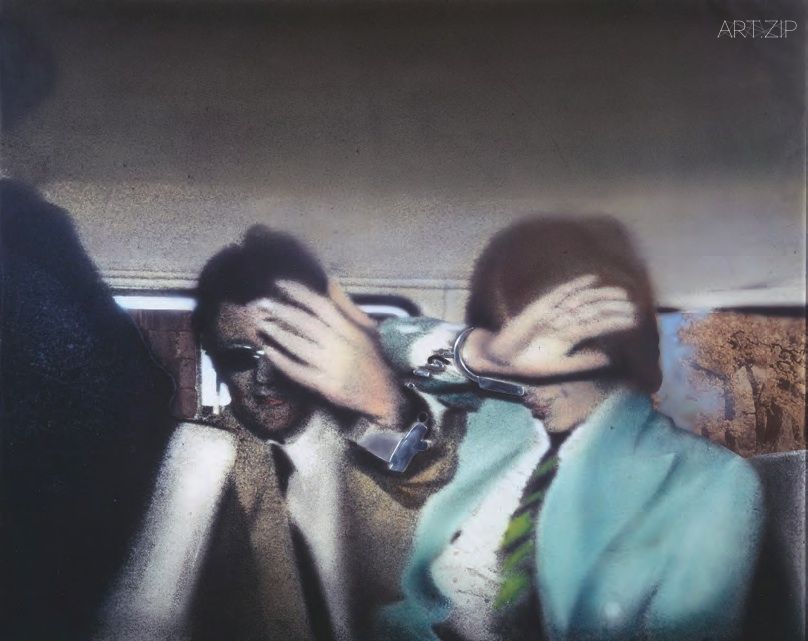
.
ORIGIN OF “POP”
“Pop” is the simplified spoken word of “lollypop” (lolly means tongue, pop is smear) which can be traced back to the 18th century, a word (here pop sound of bottle opener may be referred to) which also means the kind of Coca-Cola soft drinks (soda pop). From the word “Pop”, we can find the conversion of light-hearted pleasure and craving desire (such as the sexual innuendo of lollypop).
“波普”一詞的由來
“波普”(pop)是“棒棒糖”(lollypop,lolly是舌頭,pop是塗抹)
的一個簡化口語詞,可追溯至十八世紀,也表示可口可樂之類的「汽水」(soda pop)一詞(這裡的pop可能是指瓶子開啟的聲音)。從“Pop”這個詞中,我們都可以看到輕鬆愉快的享樂和渴求慾念的轉化(例如棒棒糖的性暗示)。
..
.
A Brief History of Pop Art
The Independent Group (IG), founded in London in 1952, is regarded as the precursor to the pop art movement. They were a gathering of young painters, sculptors, architects, writers and critics who were challenging prevailing modernist approaches to culture as well as traditional views of Fine Art. The group discussions centered on popular culture implications from such elements as mass advertising, movies, product design, comic strips, science fiction and technology.
At the first Independent Group meeting in 1952, co-founding member, artist and sculptor Eduardo Paolozzi presented a lecture using a series of collages titled Bunk! One of the images in that presentation was Paolozzi’s 1947 collage, I was a Rich Man’s Plaything, which includes the first use of the word “pop″, appearing in a cloud of smoke emerging from a revolver. Following Paolozzi’s seminal presentation in 1952, the IG focused primarily on the imagery of American popular culture, particularly mass advertising.
John McHale made subsequent coinage of the complete term “pop art” for the ensuing movement in 1954. IG members in the Second Session of the IG then used “Pop art” as a moniker in discussions in
1955, and the specific term “Pop Art” first appeared in published print in an article by IG members Alison and Peter Smithson in Arc, 1956. However, the term is often credited to British art critic and curator, Lawrence Alloway in a 1958 essay titled The Arts and the Mass Media, although the term he uses is “popular mass culture”. Nevertheless, Alloway was one of the leading critics to defend the inclusion of the imagery found in mass culture in fine arts.
Although Pop Art began in the late 1950s, Pop Art in America was given its greatest impetus during the 1960s. The term “Pop Art” was officially introduced in December 1962; the Museum of Modern Art organized a “Symposium on Pop Art”. By this time, American advertising had adopted many elements and inflections of modern art and functioned at a very sophisticated level. Consequently, American artists had to search deeper for dramatic styles that would distance art from the well-designed and clever commercial materials. As the British viewed American popular culture imagery from a distance, their views were often instilled with romantic, sentimental and humorous overtones. By contrast, American artists being bombarded daily with the diversity of mass-produced imagery, produced work that was generally more bold and aggressive.
波普藝術簡史
“波普藝術”這個術語最早在1950年代中後期出現,1952年在倫敦成立的“獨立小組”(The Independent Group)被視為波普藝術運動的先驅,這是一群年輕的畫家,雕塑家,建築師,作家和批評家組成的團體,他們挑戰當時現代主義的藝術方法論,質疑當時的藝術觀點和理念。這個小組討論的重點是大眾廣告,電影,設計產品,動漫,科技和科幻元素對流行文化的影響。在獨立小組1952年第一次會議中,共同創始人、藝術家和雕塑家愛德華多·保羅齊(Eduardo Paolozzi)在講座中使用了一系列的雙層拼貼作品,其中《我是有錢人的玩物(I was a Rich Man’s Plaything)》,首次使用了“波普(POP)”一詞,寫在一隻左輪手槍噴出的煙霧上,後面畫著一個驚嘆號,這裡的“波普”是模仿子彈發射的象聲詞。從此,獨立小組開始著重關注於美國流行文化,特別是大眾化的海量廣告。
在1954年,約翰·麥克海爾(John McHale)為隨後開展的藝術運動創造了“波普藝術”這個新名詞。“波普藝術”在1955年獨立小組討論之後成為了成員共同認可的名字,獨立小組成員艾莉森和彼得·史密森(Alison and Peter Smithson)在1956年第一次使用“波普藝術”作為專有名詞發表了文章。不過,藝術批評家兼策展人勞倫斯·阿羅維(Lawrence Alloway)往往被視作“波普藝術”這一術語的發明人,但他其實並沒有用這一術語指稱某一運動。在其1958年的論著《藝術與大眾媒體 (The Arts and the Mass Media)》中, 他沒有直接論及藝術(fine arts), 而是論證了大眾流行藝術的合法性,由此為這一新興藝術開闢了道路。
雖然波普藝術在美國的開端是在1950年代末,但是在隨後的60年代,美國波普藝術引領了整個波普藝術運動的風潮。1962年12月,現代藝術博物館舉辦了“波普藝術研討會”正式提出了“波普藝術”這樣一個術語。在當時,美國廣告產業已經非常發達,已經開始採用很多現代藝術的元素和語言,因此,美國的藝術家們不得不尋找和探索更深刻的戲劇性的藝術風格來區別於那些精心設計的精巧的商業產品。由於從英國觀看的美國流行文化意象會有些隔岸觀火,他們的意見往往被灌輸予浪漫、感傷和幽默的色彩。相比之下,美國的藝術家天天被各種大批量生產的圖像和符號所轟炸,他們的身臨其境普遍導致了創作上的更為大膽和進取。

